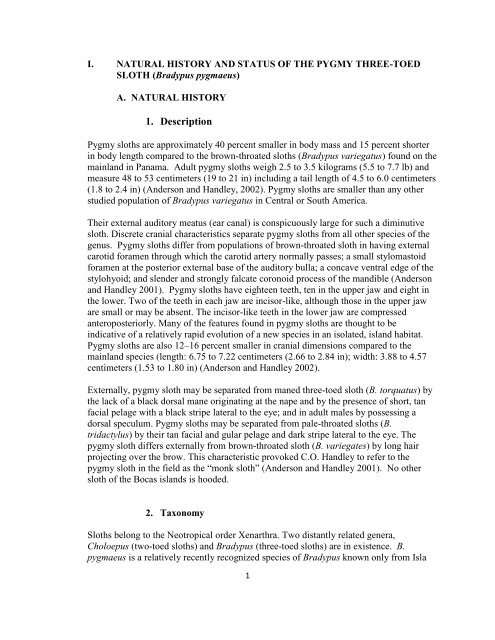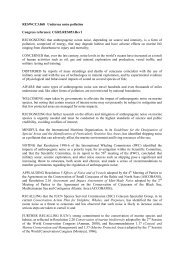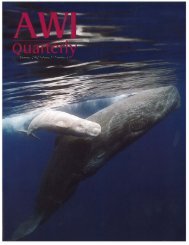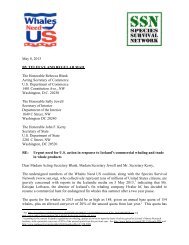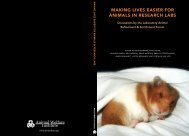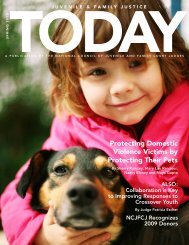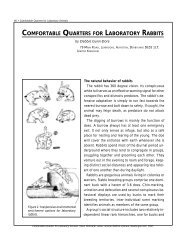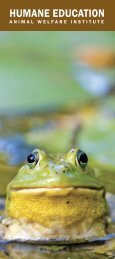EMERGENCY PETITION TO LIST THE PYGMY THREE-TOED SLOTH
EMERGENCY PETITION TO LIST THE PYGMY THREE-TOED SLOTH
EMERGENCY PETITION TO LIST THE PYGMY THREE-TOED SLOTH
Create successful ePaper yourself
Turn your PDF publications into a flip-book with our unique Google optimized e-Paper software.
I. NATURAL HIS<strong>TO</strong>RY AND STATUS OF <strong>THE</strong> <strong>PYGMY</strong> <strong>THREE</strong>-<strong>TO</strong>ED<strong>SLOTH</strong> (Bradypus pygmaeus)A. NATURAL HIS<strong>TO</strong>RY1. DescriptionPygmy sloths are approximately 40 percent smaller in body mass and 15 percent shorterin body length compared to the brown-throated sloths (Bradypus variegatus) found on themainland in Panama. Adult pygmy sloths weigh 2.5 to 3.5 kilograms (5.5 to 7.7 lb) andmeasure 48 to 53 centimeters (19 to 21 in) including a tail length of 4.5 to 6.0 centimeters(1.8 to 2.4 in) (Anderson and Handley, 2002). Pygmy sloths are smaller than any otherstudied population of Bradypus variegatus in Central or South America.Their external auditory meatus (ear canal) is conspicuously large for such a diminutivesloth. Discrete cranial characteristics separate pygmy sloths from all other species of thegenus. Pygmy sloths differ from populations of brown-throated sloth in having externalcarotid foramen through which the carotid artery normally passes; a small stylomastoidforamen at the posterior external base of the auditory bulla; a concave ventral edge of thestylohyoid; and slender and strongly falcate coronoid process of the mandible (Andersonand Handley 2001). Pygmy sloths have eighteen teeth, ten in the upper jaw and eight inthe lower. Two of the teeth in each jaw are incisor-like, although those in the upper jaware small or may be absent. The incisor-like teeth in the lower jaw are compressedanteroposteriorly. Many of the features found in pygmy sloths are thought to beindicative of a relatively rapid evolution of a new species in an isolated, island habitat.Pygmy sloths are also 12–16 percent smaller in cranial dimensions compared to themainland species (length: 6.75 to 7.22 centimeters (2.66 to 2.84 in); width: 3.88 to 4.57centimeters (1.53 to 1.80 in) (Anderson and Handley 2002).Externally, pygmy sloth may be separated from maned three-toed sloth (B. torquatus) bythe lack of a black dorsal mane originating at the nape and by the presence of short, tanfacial pelage with a black stripe lateral to the eye; and in adult males by possessing adorsal speculum. Pygmy sloths may be separated from pale-throated sloths (B.tridactylus) by their tan facial and gular pelage and dark stripe lateral to the eye. Thepygmy sloth differs externally from brown-throated sloth (B. variegates) by long hairprojecting over the brow. This characteristic provoked C.O. Handley to refer to thepygmy sloth in the field as the “monk sloth” (Anderson and Handley 2001). No othersloth of the Bocas islands is hooded.2. TaxonomySloths belong to the Neotropical order Xenarthra. Two distantly related genera,Choloepus (two-toed sloths) and Bradypus (three-toed sloths) are in existence. B.pygmaeus is a relatively recently recognized species of Bradypus known only from Isla1


